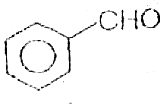(i) Givean industrial preparation of (a) formaldehyde, (b) acetaldehyde and (c) acetone
(ii) Give the methods by which ethyl alcohol may be converted into acetaldehyde
(iii) How is an aldehyde obtained from an acid chloride?
(iv) Write an equation for making aldehydes by the oxo process.
(v) How is impure acetaldehyde purified? ltbr (vi) How is impure acetone purified?
(a)CH3OH+O2873K−−→CuHCHO
(b) HC≡CHHgSO4−−−→H2SO4CH3CHOorH2C=CH2+O2PdCl2,CuCl2−−−−−−−→H2OCH3CHO (Wacker's process)
(a) By oxidation with acidified K2Cr2O7
(b) By catalytic dehydrogenation-vapours are passed over heated copper at 573K
By Rosenmund's reduction, ROCl+H2RCHO+CHl
R−CH=CH2+CO+H2Co2(CO)8−−−−−−→RCH2CH2CHO
CH3ImpureCO+NH3→CH3CH(OH)NH2H2SO4−−−→CH3(Pure)CHO+NH4HSO4
(CH3)2CO+NaHSO3→Impure(CH3)2C(OH)SO2ONaNa2CO3−−−−→(CH3)2CO(Pure)
Topper's Solved these Questions
- BOOK - OP TANDONCHAPTER - ALDEHYDES AND KETONES EXERCISE - MATCHING TYPE1videos
ALDEHYDES AND KETONES
- BOOK - OP TANDONCHAPTER - ALDEHYDES AND KETONES EXERCISE - PROBLEMS BASED ON STRUCTURE AND PROPETIES17videos
ALDEHYDES AND KETONES
- BOOK - OP TANDONCHAPTER - ALDEHYDES AND KETONES EXERCISE - ILLUSTRATIONS OF OBJECTIVE QUESTIONS12videos
ALDEHYDES AND KETONES
- BOOK - OP TANDONCHAPTER - ALCOHOLS, PHENOLS AND ETHERSEXERCISE - SINGLE INETER ANSWER TYPE QUESTIONS / ALCOHOLS AND PHENOLS15videos
ALCOHOLS, PHENOLS AND ETHERS
- BOOK - OP TANDONCHAPTER - BASIC PRINCIPLESEXERCISE - SECTION V INTEGER ANSWER TYPE QUESTION3videos
BASIC PRINCIPLES
Similar Questions
How will you prepare the following ?
(i) Acetoxime from acetaldehyde. (ii) Propionic anyydride from propionaldehyde.
(iii) Acetone from acetylene, (iv) α−Hydroxypropionic acid from acetaldehyde.View Solution(a) Describe the preparation of acetic acid from acetylene. How can the following be obtained from acetic acd ?
(i) Acetone (ii) Acetaldehyde
(b) In what way can acetic acid be distinguished from acetone ?
(c) Why does carboxylic acid not give the characteristic reactions of a carbonyl group ?View SolutionHow will you synthesise ?
(i) Acetamide from acetone.
(ii) lodoform form acetic acid .
(iii) Malonic acid from acetic acid .
(iv) Crotonic acid from acetaldehyde .View SolutionHow will you synthesise?
(i) Acetic acid from methyl iodide
(ii) Iodoform irom acetic acid,
(iii) Acetic acid from propionic acid.
(iv) Glycine from acetic acid (v) Butylamine from propionic acid.
(vi) Ethylamine from propionic acid.
(vii) α-Hydroxy propionic acid from acetaldehyde
(viii) Acetamide from acetone. (ix) Acetaldehyde from acetic acid
(x) Methyl cyanide from acetic acid.
(xi) Crotonic acid from acetaldehyde.
(xi) Pyruvic acid from ethyl bromide (xiit) Succinic acid from ethyl bromide
(xiv) Oxalic acid from methyl alcohol.
(xv) B-Hydroxy propionic acid from ethylene oxide.
(xvi) Tartaric acid from ethylene.
(xvii) Malonic acid from acetic acid.
(xviii) Lactic acid from acetic acid.
(xix) 2-Phenylethanoic acid from benzene.
(xx) p-Carboxyphenylacetic acid from p chlorotoluene
(xxi) m-Fluorobenzoic acid from benzoic acid
(xxii) o-Bromobenzoic acid from toluene.
(xxiii) Aniline from benzoic acid.
(xxiv) Salicylic acid from benzene.
(xxv) Cinnamic acid from benzene.
(xxvi) p-Met ylbenzoic acid from toluene.
(xxxvii) p-Hydroxy benzoic acid from toluene.
(xxviii) Benzoic acid from aniline.
(xxix) Aniline from benzoic acid.
(xxx) Phthalimide from phthalic acid.View SolutionHow will you differentiate between?
(i) Aceetaldehyde and acetone.
(ii) Aldehydes and ketones with (i) Tollens's regent (ii) Fehling's solution
(iii) Acetone and diethyl ether
(iv) Formaldehyde and acetaldehyde.
(v) Ethyl alcohol and acetone
(vi) Formaldehyde and ethyl alcohol
(vii) Pentan-2-one and pentan-3-one
(viii) Benzaldehyde and acetophenone
(ix) Benzaldehyde and acetaldehyde ltbr (x) Benzaldehyde and introbenzene.View SolutionGive suitable explanation for the following:
(i) Chloral hydrate is a geminaldiol but still stable. How?
(ii) Out of and CH3CH2CHO which is more reactive nucleophilic addition?
and CH3CH2CHO which is more reactive nucleophilic addition?
(iii) Why does pure HCN fail to reac with aldehydes and ketones?
(iv) Hydrazones of aldehydes and ketones are not prepared in strongly acidic mediu. Why?
(v) Sodium bisulphite is used to purify aldehydes and ketones. Explain.View SolutionHow are the following compounds obtained from calcium salts of fatty acids:
(1) Formaldehyde (2) Acetaldehyde (3) Acetone?View SolutionHow will you preform the following conversions?
(i) Acetaldehyde to acetone
(ii) Propanone to propene
(iii) Propene to propanone
(iv) Benzaldehyde to benzophenone
(v) Benzene to acetophenoneView SolutionWhat happens when (Give equation only)
(i) Calcium acetate is heated.
(ii) Acetaldehyde is heated with aqueous sodium hydroxide solution
(iii) Formaldehyde reacts with sodium hydroxide.
(iv) Acetone is treated with HCN and the products is boiled with an acid.
(v) Formaldehyde is treated with methyl magnesium bromide and the product is then hydrolysed.
(vi) Ammonia reacts with formaldehyde.
(vii) Ammonia reacts with acetone
(vii) Chloral is heated with aquesous sodium hydroxide.
(ix) Acetdehyde reacts with Fehling's solution
(x) Acetone is deistilled with conc. H2SO4View SolutionGive suitable explanation for the following:
(i) Chloral hydrate is a geminaldiol but still stable. How?
(ii) Out of and CH3CH2CHO which is more reactive towards nucleophilic addition?
and CH3CH2CHO which is more reactive towards nucleophilic addition?
(iii) Why does pure HCN fail to react with aldehydes and ketones?
(iv) Hydrazones of aldehydes and ketones are not prepared in strongly acidic medium. Why?
(v) Sodium bisulphite is used to purify aldehydes and ketones. Explain.View Solution

